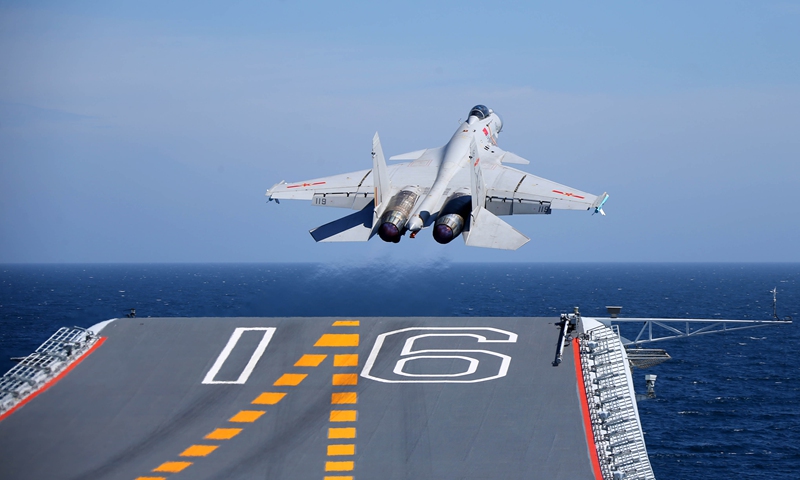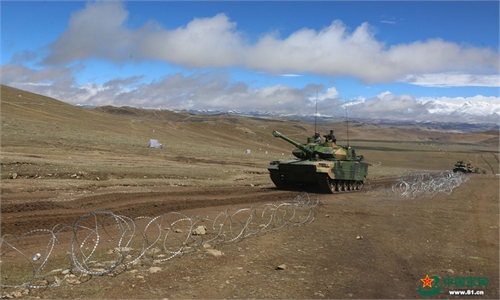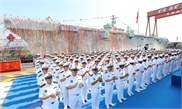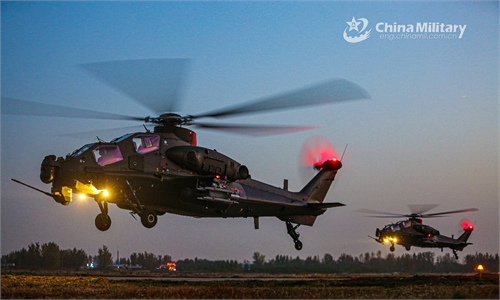Aircraft carrier Liaoning embarks on voyage, sets fighter jet pilot training history

A J-15 carrier-borne fighter jet takes off from the flight deck of the aircraft carrier Liaoning during a maritime training exercise on July 1, 2017. The Chinese aircraft carrier Liaoning and its carrier strike group carried out realistic training in an undisclosed sea area on July 1, 2017. (eng.chinamil.com.cn/Photo by Li Tang)
The Chinese People's Liberation Army (PLA) Navy aircraft carrier Liaoning has been at sea over the past week, making history by qualifying the first batch of new fighter jet pilots who were directly recruited from high school and trained specifically to fly carrier-based aircraft.This new pilot training mode, together with the previous mode that see pilots of traditional aircraft switch to carrier-based aircraft, can effectively cultivate new pilots for carriers and fulfill the demand of China's growing aircraft carrier fleets, analysts said on Friday.
In early November, the Liaoning sailed to the Bohai Bay and ran certification exams for a new batch of carrier-based fighter jet pilots from PLA Naval Aviation University, according to a statement the PLA Navy's WeChat public account released on Friday.
J-15 fighter jets flew by the pilots successfully landed on the carrier during the exams, the statement said.
With an average age of 20, the newly qualified pilots are from the first batch of carrier-borne fighter jet pilot cadets directly recruited from high school and enrolled at the university, the statement said, noting that this new pilot development mode, dubbed the "cultivation mode," is successful.
The "cultivation mode" and "switch mode" that trains traditional aircraft pilot to fly carrier-based aircraft will together play significant roles in building Chinese aircraft carriers' combat capabilities, the PLA Navy said.
Beijing-based naval expert Li Jie told the Global Times on Friday that the pilots trained via the "cultivation mode" are younger, more agile and have a solid education background, which means they can quickly master operating a vessel-borne aircraft.
The "switch mode" is very important in the early stage when China did not have enough "cultivation mode" pilots to carry out the missions, Li said.
Although switched pilots may have accumulated flight experience in previous service, such experience is not necessarily helpful as muscle memory may hinder them from adapting to shipboard aircraft, Li said. Pilots usually throttle down the engine when landing, but for carrier-based aircraft pilots, they need to keep that or even throttle up.
The Liaoning has set four other new records in the fighter jet pilot program, namely the largest number of pilots qualified for fighter jet operations on an aircraft carrier in one test, the youngest average age, the lowest time needed for flight training, and the shortest period used for certification, according to the PLA Navy statement.
China's aircraft carrier-based fighter jet pilot cultivation program has entered an express highway, it said.
In addition to fighter jet pilots, China's aircraft carrier talent cultivation programs are also training personnel for special mission aircraft, helicopters, combat logistics and drones, the statement said.
China now operates two aircraft carriers, the Liaoning and the Shandong, after the latter entered PLA naval service in December 2019. The two completed regular exercises and sea trials in September, China 's Ministry of National Defense announced at that time.
This is also the first time known to the general public that the Liaoning has set out for a voyage since the September exercises.
China is reportedly building a third aircraft carrier in Shanghai. It will be larger than the current two carriers and carry more fighter jets, analysts predicted.
The PLA Navy needs to rapidly cultivate more carrier-based aircraft pilots to meet the demands of the new aircraft carriers, experts said.




